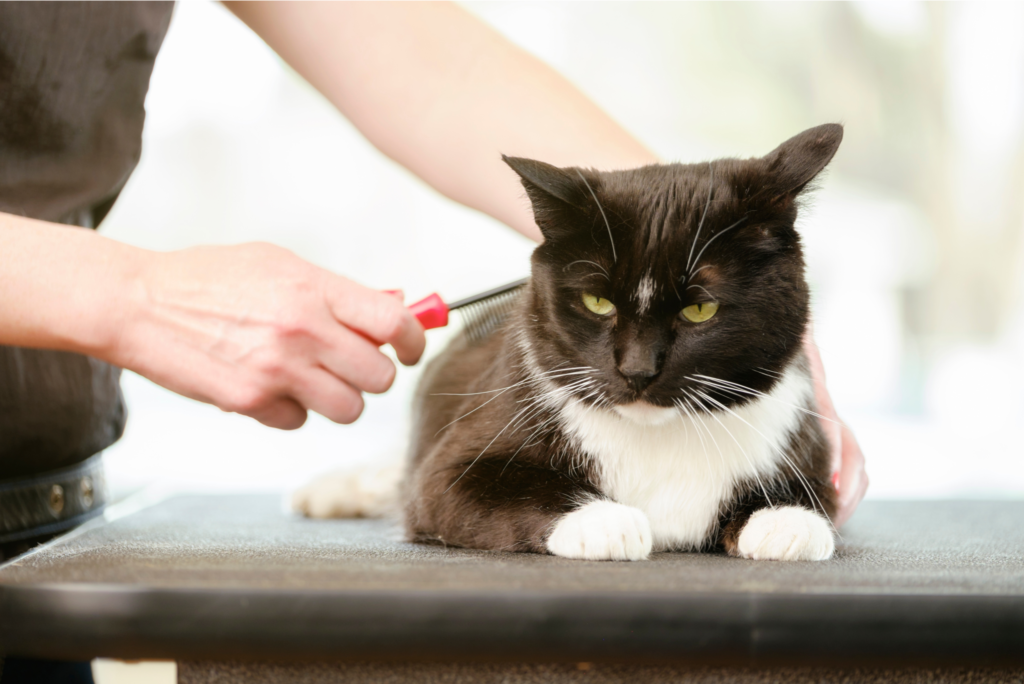For cats, whiskers are a signature feature, and they are unusually longer for a reason. Cutting a cat’s whiskers during grooming can make them uncomfortable, as cats may lose some of their senses, affecting their daily activities. This article aims to discover the purpose of a cat’s whiskers and the adverse effects that may occur if you cut the whiskers off a cat.
Groomer Cut Cat Whiskers
Trimming a cat’s whiskers can disrupt their delicate balance and spatial awareness, making navigation and sensing their environment a challenge. Such an act by a groomer not only robs cats of their natural navigation tools but also may leave them disoriented and stressed. Always trust a professional groomer who understands the importance of leaving those vital sensory whiskers untouched for your cat’s well-being and happiness.

Reasons Why Trimming Cat’s Whiskers is Not a Good Idea
For cats, whiskers are a signature feature, and they are unusually longer for a reason. Cutting a cat’s whiskers during grooming can make them uncomfortable, as cats may lose some of their senses, affecting their daily activities. This article aims to discover the purpose of a cat’s whiskers and the adverse effects that may occur if you cut the whiskers off a cat.
-
Whiskers Have a Sensory Function:
Whiskers play a crucial role as a sensory function for Cats, helping them coordinate their senses in hunting prey or navigating in the dark. Trimming them can lead to negative consequences.
-
Whiskers Serve as their Navigation Tool:
Whiskers act as a navigation tool, aiding Cats in fitting into narrow spaces and estimating space size, crucial for their sensory functions.
-
Whiskers are Partly Responsible for Their “Nine Lives”:
The whiskers of a cat are partly responsible for their famed ability to survive numerous accidents, aiding in balance and proprioception.
-
Whiskers Give You a Signal:
Cats’ whiskers reflect their emotions; they can signal whether a cat is relaxed, agitated, or frightened, providing valuable behavioral insights.
-
Whiskers Serve as their Protection:
Whiskers offer protection by sensing dangers like sharp objects and even dust particles, helping cats to navigate and protect their eyes.
Also Read: How to Become a Cat Groomer?
Should You Trim Cat Whiskers
It may be tempting to trim your cat’s whiskers when they droop, stick straight out, or are of varying lengths and colors some light-colored and others dark and rough-looking. However, before you reach for the scissors, stop and ask yourself if you should. The answer is, you should never trim a cat’s whiskers.
Cutting them can leave your cat disoriented and experience anxiety, as whiskers show a vital role in their everyday life. They should be left alone to help the cat walk and stay balanced. It’s essential for cats to learn and read their surroundings, so their whiskers need to be undisturbed.
Is It Bad to Touch a Cat’s Whiskers?
It’s advisable to refrain from touching a cat’s whiskers too much. While you might be trying to see how long they are or if they need a trim, remember that whiskers are highly sensitive and can hurt if pulled or touched too often. Cats generally do not appreciate their whiskers being interfered with.
Does Cutting a Cat’s Whiskers Hurt Them?
Cutting a cat’s whiskers can be hurtful and detrimental to their happy and healthy life. Whiskers are important for a cat to walk and fit into tight spaces. Physically, whiskers have nerve endings and blood vessels, so cutting them can cause pain or even bleed. This can degrade their quality of life. Even if they don’t bleed, the blunt or sharp edge from a cut can poke and be uncomfortable for the cat. Whiskers have soft points that are unnaturally cut when trimmed.
Do Cat Whiskers Grow Back When You Cut Them
Yes, cat whiskers do grow back after being cut, so there’s no need to worry if they’re accidentally trimmed. Much like fur, whiskers continue growing. If you think they’re like a crack that, once damaged, will fall out and be gone forever, that’s not the case. They may initially appear uneven in length or have a stubby end instead of the fine point they used to be, but they will shed and regrow, misshapen whiskers will be replaced with ones good as new.Top of Form
Do Cat Whiskers Keep Growing
Cat whiskers do keep growing throughout their life. When they are trimmed, they grow back to match the size of the cat. As cats gain weight or get bigger, their whiskers grow to fit their new size. For kittens, whisker growth will stop when they reach a certain size, ensuring the whiskers are not longer than necessary and avoid touching the ground.
Also Read: Cat Grooming for Difficult Cats
Why Do People Trim Cat Whiskers?
Some people cut cat whiskers for cosmetic reasons, thinking it improves their look by making them appear shorter or more groomed, often a personal choice. Owners of long-haired or larger cats might find their cat’s long fur makes the whiskers appear finer and droop, giving an older and tired look, while short-haired cats have whiskers that jut straight out, which can look funny to some. Others might trim whiskers if they are broken or uneven, not realizing these are essential and naturally prone to breaking. There’s a temptation to even out the whiskers, but it’s important to understand their vital role.

Why You Should Not Cut A Cat’s Whiskers?
Factors That Affect a Cat’s Whiskers
There are several factors that affect a cat’s whiskers. Firstly, their health plays a vital role; thin or damaged whiskers can be a sign of a sick or malnourished cat. Age is also a factor; older cats may naturally have thinning whiskers. Environmental conditions like extreme temperatures and humidity can affect their whiskers too.
Lastly, genetics also play a part, with some breeds having naturally longer or thicker whiskers. These factors underline why it’s important not to cut a cat’s whiskers, as they are essential for their wellbeing and environmental interaction.
Are There Any Situations In Which It May Be Necessary To Trim A Cat’s Whiskers?
-
Vet-Approved Procedures
In the realm of vet-approved procedures, there are rare instances where trimming a cat’s whiskers might be deemed necessary, particularly in the context of surgery or other medical procedures. Whiskers are not mere fur but essential sensory appendages for cats, vital for their spatial awareness.
However, during certain medical procedures, a veterinarian might determine that trimmed or shaved whiskers could minimize the risk of complications. This is always a last resort measure, taken with the cat’s well-being at heart and under stringent necessary precautions to avoid any negative consequences.
It’s crucial to remember that such decisions are exclusively within the purview of professional veterinarians and should not be undertaken by pet owners or groomers.
-
Trimming Excessively Long Whiskers to Prevent Matting
In the rare case of excessively long whiskers causing matting or tangling, it might be prudent to consult with a professional groomer or a veterinarian. While typically whiskers do not require trimming, in these exceptional circumstances, a professional might assess the situation and decide if a trim is necessary. This decision is made with the utmost care to ensure it’s safe and does not harm the cat.
Also Read: Medical Grooming for Cats
Important Note:
The decision to trim or shave a cat’s whiskers should never be taken lightly. It’s a procedure that, if deemed necessary, must be handled by a professional who understands how to minimizes the potential negative consequences. If you’re unsure about the need for trimming your cat’s whiskers, always consult with a veterinarian or a qualified groomer.
What to Do If You Accidentally Trim Your Cat’s Whiskers?
If you accidentally trim your cat’s whiskers, it’s essential to be aware that your cat may experience distress or discomfort. The first step is to seek veterinary attention. A veterinarian can assess the situation and provide treatment and guidance for care and recovery. Meanwhile, monitor your cat’s behavior closely for signs of well-being issues such as disorientation or increased anxiety.
If you notice difficulty navigating or any other concerning symptoms, consult your vet immediately. To help your cat adjust, be extra cautious around your house. Keep an eye out for potential hazards like moving objects and sharp edges to prevent injury. Set up a safe, familiar space in a small room with familiar objects, food and water bowls, and a cozy bed to reduce stress and anxiety, offering a sense of security until the whiskers grow back.
Conclusion
The whiskers of a cat are a key aspect of their sensory apparatus, crucial for navigation, balance, and environmental interaction. Trimming or cutting them can lead to disorientation, stress, and compromised well-being. While there are very rare instances where trimming might be necessary, these are exceptional cases best left to professionals. As cat owners, understanding and respecting the natural function and importance of whiskers is essential. By avoiding interference with their whiskers, we support our feline companions in leading a comfortable, safe, and happy life, fully in tune with their extraordinary sensory abilities.
People Are Also Interested In:
Does Cutting a Cat’s Whiskers Hurt Them?
Cutting a cat’s whiskers does not cause physical pain like cutting men’s bristly facial hair, but it can disrupt their delicate sensory function, similar to antennas that deliver nerve signals to the brain.
What is the Purpose of a Cat’s Whiskers?
A cat’s whiskers are finely tuned sensing devices, akin to the antennae of butterflies, serving to assist in perception and explore surroundings, thus supplying extra sensory feedback for everyday tasks.
Also Read: Cat Not Grooming Lower Back
What is Cat Whisker Fatigue?
Cat Whisker Fatigue is a form of whisker exhaustion caused by over-stimulation of their sensory system, making them stressed and irritated, often leading to a failure to eat or drink from their daily dishes.
Do Cat Whiskers Hurt When Cut?
Cutting a cat’s whiskers is not painful, but it can cause discomfort and disorientation due to the loss of sensitivity and balance, leading to problems for a period of time.
Do Cats’ Whiskers Grow Back If Cut?
Yes, cats’ whiskers do grow back if cut. In a scenario where a groomer accidentally cuts one side, there’s no need to panic; it may take a long time, but they will regrow unless the follicles are damaged. However, it’s a problem if they are never cut off except for necessary medical reasons.
Do Cat Whiskers Have Nerves?
Yes, cat whiskers have nerves; their follicles contain several blood vessels, making them a highly sensitive area.







